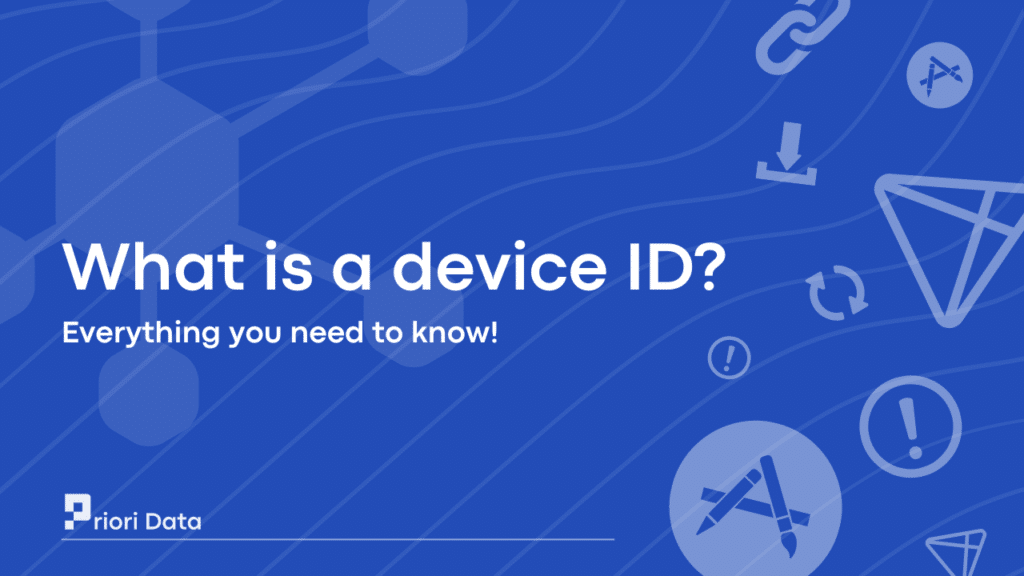A device ID or device identification is a unique number of a smartphone, tablet, or a similar handheld device. It is a distinctive and anonymized combination of numbers and letters and helps identify the device user.
Usually, a device ID is stored on the mobile, and any downloaded and installed application on the mobile can retrieve it.
It is then utilized to depict the user’s behavior while using the application. For instance, it can be used by advertisers to analyze if the users are clicking on their ads or not.
Marketers and services can also use the device ID to track a particular device.

How do app owners or marketers use device ID?
Any installed app can retrieve the device ID as soon as it is launched. As it launches, marketers measure the installation and tie it to the user’s previous activity to use it for attribution purposes.
It can be understood with the below example:
A user is using the smartphone and clicks on an ad that directs him to the app store. As the user downloads the app and installs it, the attribution Software Development Kit (SDK) triggers and records the installation.
After recording, it goes back to view the ID on its database. If a match is within the same attribution window, the ad gets the credit for compelling the user to download and install the app.
This way, the effectiveness of an ad campaign is also measured.
Does the device ID give out personal information?
It is one of the major concerns among mobile users.
Device ID helps to identify the user anonymously. Even though the installed applications can retrieve the device ID, it does not give any personal information like name, address, email, or information regarding payments and credit cards.
With the help of device ID, app owners can get an insight into:
- User’s journey in the app
- In-app activities of the user
- The success of in-app events
Developers and marketers obtain these data without getting any access to users’ personal information.
As we have seen a paradigm shift toward user privacy, preference is now given more to aggregated data over user-level data. To meet this concern, Apple introduced App Tracking Transparency (ATT). Under it, the application owners have to get permission to obtain a device ID and track the user’s in-app activity.
It is a great step towards maintaining the privacy of the users.
What are the different types of device IDs?
There are two types of device IDs based on the operating system of the device. They are as follows:
1. IDFA- ID for Advertisers
Apple uses IDFA, wherein a unique combination of 8 digits, followed by a dash, and three sets of 4 digits are present. All the letters in IDFA are in uppercase. It helps the owner to map the user’s journey and actions with an ad campaign.
Apart from app developers and marketers, customers can also retrieve their device IDs. It can be accessed in iTunes or by downloading certain free apps from the App store.
2. GAID- Google Advertiser ID
It is used by Android and consists of the same combination of digits and letters as in IDFA. What makes it different from IDFA is the use of letters in lowercase. It works in a similar manner as Apple.
Android users can also access their device ID through free apps from Google Play.
Note: It is not necessary that an Android or Apple device will have a constant device identification number throughout its life. The device ID changes with every factory reset. It is because factory reset formats data where the device ID is stored and creates a new device identification number.
What is the use of device ID?
Device ID benefits app marketers significantly. With its help, marketers can analyze the following:
- Measure the pre-install engagement of the user
- Map the user’s journey
- Check install and post-install in-app events
By getting a sneak peek into these, evaluating the marketing activities and mapping the users’ journey becomes hassle-free. It helps in understanding the effectiveness and feasibility of their ad campaigns.
Some major benefits of knowing the device identification number include the following:
1. Enables businesses to make data-driven marketing decisions
According to Statista, the number of smartphone users worldwide is approximately 6,841 million, which will increase every year. With the help of device ID, companies will be able to develop a robust relationship with their customers and improve it further.
2. Helps companies create and deliver personalized ads
To acquire more customers and improve retention, companies can create personalized ads based on the data collected through device ID. The information can also be used to segment the target audience and deliver customized ads. It also helps target the right people at the right time.
3. Aids in improving engagement and conversion
The device identification number is a deterministic identifier and the most accurate attribution method. It helps companies make a one-on-one connection with the users and improve engagement. At the same time, it enables marketers to fill the voids and increase conversion.
4. Evaluates high-impact publishers and networks
Based on network distribution and impression frequency measurements, marketers can understand the effectiveness of the publishers and networks. It will give an idea about the time required to run ads on the networks at a better frequency.
5. Easy segmentation of users
With the help of collected data, sharpening audience segmentation becomes easy. Device ID will give a better understanding of the users and their engagement. Also, it shows when, where, and why the users engage. With all this information, the audience can be grouped based on usage patterns, device type, and more.






